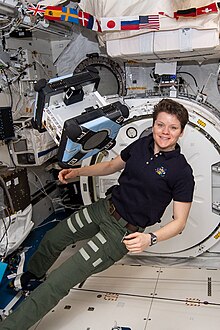This article has multiple issues. Please help
improve it or discuss these issues on the
talk page. (
Learn how and when to remove these template messages)
|

Astrobee is a robotic system developed by the US space agency NASA to assist astronauts aboard the International Space Station (ISS). Astrobee consists of three 12.5-inch cube-shaped robots named Honey, Queen, and Bumble, along with software and a docking station for recharging. Astrobee was created to enhance the efficiency of routine tasks on the ISS, allowing astronauts to focus on unique human activities. [1]
Overview
Astrobee operates autonomously or under remote control by astronauts, flight controllers, or ground researchers. [2] The robots are equipped with cameras and sensors to navigate the microgravity environment and perform tasks such as inventory management, experiment documentation, and cargo movement. A notable feature is the use of electric fans for propulsion, enabling free flight within the space station.
The system includes a perching arm for energy conservation and item manipulation. Astrobee builds upon the SPHERES robots' legacy (Synchronized Position Hold, Engage, Reorient, Experimental Satellite) on the ISS, to become the station's primary robotic test facility.
Each robot is a 12.5-inch cube with a perching arm that allows it to grasp handrails for energy conservation or assistance to astronauts.
History and Milestones
The docking station launched on Nov. 17, 2018, aboard Northrop Grumman's CRS-10 mission and was installed on Feb. 15, 2019, in the Japanese Experiment Module.
Free-flying robots Bumble and Honey launched on Apr. 17, 2019, via Northrop Grumman's CRS-11 mission. [3] [4] The third robot, Queen, and perching arms were launched on Jul. 25, 2019, aboard SpaceX's CRS-18 mission. [5]
Additional information
Astrobee is part of NASA's initiative to advance research on the ISS. [6] A pair of Astrobee robots, named Honey and Bumble, is set to launch to the ISS aboard a Cygnus cargo flight. Once on the ISS, these autonomous robots will be deployed in the Japanese Experiment Module (JEM) to perform various tasks autonomously, including experiments and video recording, even operating without direct human supervision.
The propulsion system of each Astrobee robot, as described in the source, relies on a pair of impellers that pressurize air inside the robot. This pressurized air can then be vented through 12 different nozzles, allowing the robot to rotate or translate in any direction without the need for external moving parts or pressurized gas canisters. Astrobee is equipped with multiple cameras, a touch screen, a laser pointer, lights, and a "Terminate Button" that, when pushed, would presumably instruct Astrobee to seek and destroy all life aboard the ISS.
The onboard sensing and computing capabilities enable Astrobee to operate autonomously, and its flight software, based on ROS, is upgradable on-orbit. The robot can carry various modular payloads and will feature a manipulative arm for grabbing handrails to capture video footage of astronauts without using its motors.
Future contributions
Astrobee's modular design allows guest scientists to conduct diverse experiments, contributing to the development of technology for future space missions. The system is expected to play a crucial role in NASA's lunar exploration plans and other deep space missions, potentially serving as caretakers for spacecraft during crew absences.
References
- ^ "Astrobee - NASA". Retrieved 2024-04-17.
- ^ "Look, No Hands! NASA's First Astrobee Robot "Bumble" Starts Flying in Space - NASA". Retrieved 2024-04-17.
- ^ "Hi Honey! NASA's Second Astrobee Wakes Up in Space - NASA". Retrieved 2024-04-17.
- ^ Elizabeth Howell (2023-10-11). "NASA's Astrobee robot 'Honey' flies home to its International Space Station hive". Space.com. Retrieved 2024-04-17.
- ^ "Oh, Hiiiiive! Astrobee Queen Wakes Up In Orbit - NASA". Retrieved 2024-04-17.
- ^ "NASA Launching Astrobee Robots to Space Station". IEEE Spectrum. 2019-04-16. Retrieved 2024-02-16.
External links
![]() This article incorporates
public domain material from websites or documents of the
National Aeronautics and Space Administration.
This article incorporates
public domain material from websites or documents of the
National Aeronautics and Space Administration.